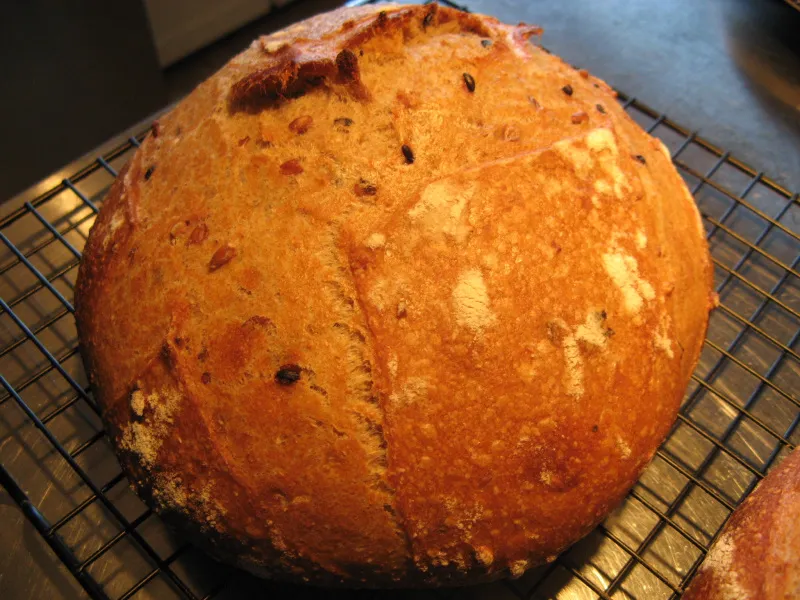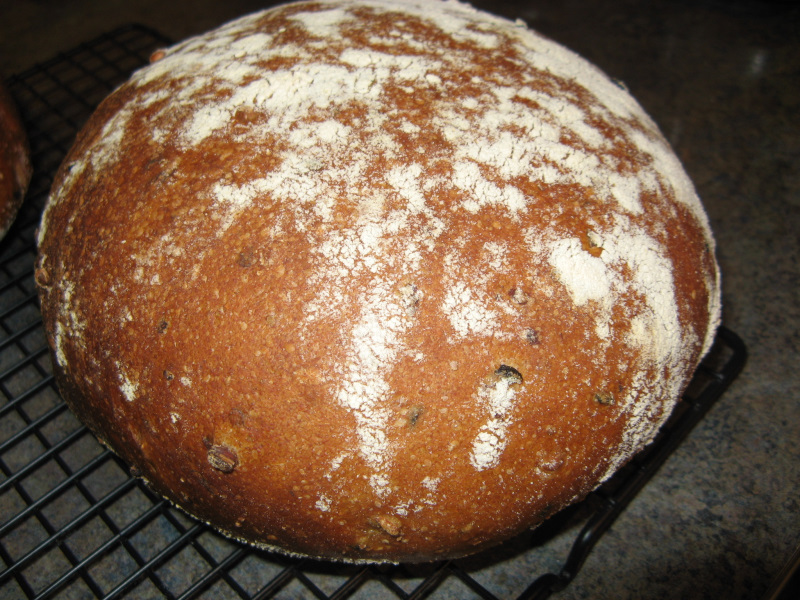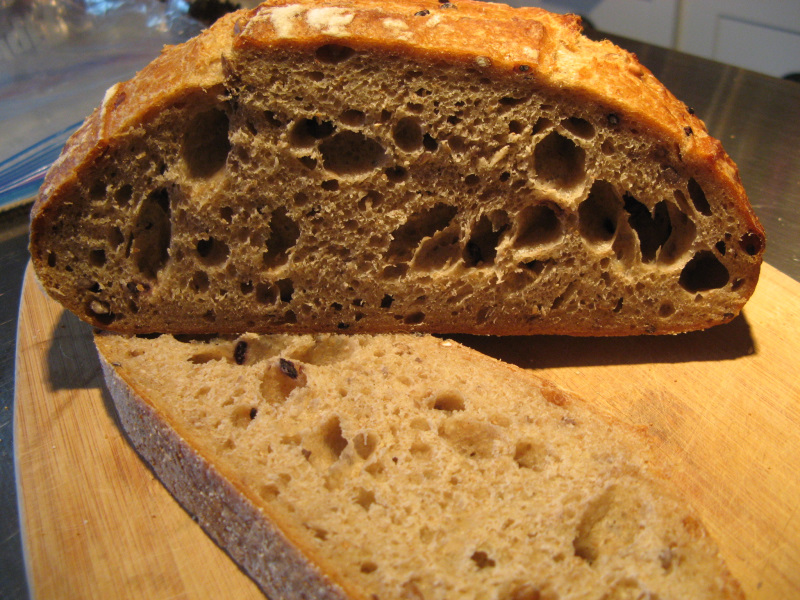
Being the end of the year (how did that happen again so soon?), I decided to clean out the pantry to see what bits and bobs of flour and grain I had left and make something out of them. Man, I acquire a lot of kinds of flour over the year! I browsed the 'net and my books for some appropriate recipes and modified to fit.
I ended up using half bread flour (Rogers Silver Star) and a blend of sifted whole wheat flour, sprouted spelt, barley flour and oat flour for the other half (mostly sifted whole wheat). The hydration level ended up a bit too high (80% water but my starter was pretty high hydration too; lesson learned - use stiffer starter or reduce the water). Used about 20% fresh levain (bread flour) and 2% salt.
Then, just for fun, I soaked a bunch of mixed grains (cracked wheat, wheat berries, rye and barley grains and black rice) in water and a bit of home-made kombucha, and worked about a quarter cup per loaf into the dough along with the salt.
I used Ken Forkish's method - mix flours and water by hand and autolyze for 30 minutes, then sprinkle the salt (and the grains) over the top, dump the starter onto it and fold / pincer until it's well-mixed. Did 4 stretch-and-folds over a couple of hours then bulk fermented in the fridge overnight.
The next morning it went into floured baskets for a couple of hours while the oven (with the big slabs of granite) pre-heated to 475. Turned it out onto floured peels, slashed, then into the oven with hot water in the pan and a quick spritz. Five minutes at 475 then down to 425 for a total of about 40 minutes.
The crumb is delicious - moist and almost gelatinous, with toothiness from the grains and a fabulous flavour. When I made a second batch, the hydration caused me some problems - when I turned the loaves out onto the peels they had the consistency of half-set jello. No slashing, just slide it into the oven quick before it oozed off the side of the peel! Still delish, though.



Nice bake. Has to be tasty with everything g you got in it. Sometimes the best things happen when you use what is at hand.
Sprouts, soaker whole grains and Kombucha too! Two pots of kombucha in a week must mean it is the new thing in bread making :-) Well done and Happy baking in 2016
Happy New Year LL
Lazy Loafer
I like your handle and I like your style. You took a lot of risks. What better way to figure anything out?
Are you brewing it or buying it? I need some expert advice on brewing, if you are. I've got a healthy SCOBY, but I am somewhat lost past that.
dbm
I was hesitant to call a Kombucha starter 'sourdough', but it clearly is.
I'm currently doing a bastardized Vermont SD with caraway, Kombucha style. Keeping it simple. Baby steps for now.
dobie
Hey dobie! I brew my own kombucha; it's way cheaper that way and I know exactly what is in it. Basically, I boil 2 litres (quarts) of water then add two black tea bags and two green tea bags, and half a cup of sugar. Brew for ten minutes then cool it to room temperature (that takes quite a while, so I brew in the morning and make kombucha in the evening). I have a large glass brewer with a tap on the bottom. I draw off the finished kombucha, then top up the brewer with the newly-brewed tea. I usually do this about every 7 to 10 days, and always have a second healthy scoby floating on the top (I remove the old one and either compost it or give it away, then brew the new batch with the new scoby). Does that help?
I think I'll start a new thread, asking people what they have used to either make poolish (or other pre-ferments) or for soaking grains. Lots of interesting flavours to experiment with!
Wendy, I am so glad that you do. And at $5 a bottle, is it any wonder? I have many questions, if you can bear them.
The making of the tea, the sugar and dilution is what I have also done so far, no doubt why I got a SCOBY to grow at all.
I also ended up with a second layer of SCOBY after my first feed, and I wonder a few things. First, is the top one or the bottom one the one to keep (or does it matter at all)? Or do you just 'let it ride'?
When you draw brew from the bottom spout, how acidic is it, how would you control the aciditiy, and is it effervescent at all?
I might be able to answer my own questions by your response, but I just want to be sure.
So every 7-10 days you give it a feed. How low can you let the level go before a re-feed? I would guess to just about the bottom. You can feed it earlier if need be? What would it take to kill a SCOBY (not that I want to, just to avoid it)?
Do you infuse it with flavors (ginger, herbs, fruit, etc.) and if so how? Do you keep a seperate 'pure' mother aside from the flavored?
Do you ever 'bottle' it, and if so how?
I've got more, but I think that will do for now.
Thanks for the response and TIA any info you can give me.
dobie
ps - just to mention; Oh, the bread.
Hmmm, let's see if I can answer them all!
It's good stuff; I drink it every day!
Yes, LL, I think you did well.
Thank you so much for all the detail. Who knew (well, you did; and now I do too).
I will put this all into effect promptly.
One last major question. Is there a possibilty of toxicity if not done correctly? Or is it pretty much 'self-regulating'?
Ahh, so you do bottle it. If I were to do so, can I just sterilize some screw top beer bottles and caps, or do I need to go further? I do like the slight effervescence of the second fermentation (as a drink), which I think is what I'm used to when bought from a market.
I'll guess that as long as the SCOBY is healthy, I can feed it, or split it and feed it at anytime.
And yes, I've heard that people even eat it. Kinda like sushi, I would guess (at least texturally). Maybe someday I will take a bite (if I dare). Just kidding, of course I will (eventually) as SCOBY is my friend.
Thanks again for all the insight.
dobie
I haven't heard of any toxicity issues, though if your scoby has black patches or there is white or grey mold growing on the surface I would throw out the batch. I'm careful to use clean hands when fishing out the old scoby, and to not introduce anything but fresh brewed tea into the container with the scoby, but other than that I don't fuss too much. Oh, and the fruit flies love it, so I keep the brewer covered with an old finely woven cotton hankie.
If you use screw top bottles be very careful to check them for pressure. If it is still fermenting it can blow up a bottle pretty quickly! Especially if you introduce another source of food (e.g. fruit or juice).
LL
Good to know. Yes, I try to be as sterile as possible, fresh gloves, etc.
And I do cover it with a heavy duty paper towel with a rubberband closure.
And I will take heed to be careful when bottling a second fermentation (or at least I'll try to duck).
Thanks again,
dobie